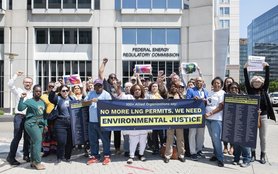One year after typhoon Haiyan, recovery is slow and Asian governments still unprepared for climate change
A year after super-typhoon Haiyan devastated the Philippines, many governments in Asia, including Bangladesh, Vietnam, Indonesia, Pakistan, and the Philippines, are not doing enough to improve their capacity to protect their citizens from extreme weather despite the region's high vulnerability to climate change, according to a new report issued today by international relief and development organization Oxfam. Oxfam warned that recovery from Haiyan is slow and governments in the region are still flat footed in the face of increasingly dangerous conditions.
The report, Can’t Afford to Wait, shows that people in Asia are already bearing the burdens of increasingly extreme weather, without adequate support from their leaders or the global community. In 2013, 78 percent of people killed by disasters lived in Asia even though only 43% of global disasters occurred there. Over the past 20 years, Asia has borne almost half the estimated global economic cost of disasters triggered by natural phenomena, amounting to almost $53 billion USD annually.
“The trend lines are very clear, growing numbers of people in Asia face serious danger from increasingly extreme conditions, the biggest uncertainty is whether local governments will be prepared,” said Shannon Scribner, Humanitarian Policy Manager for Oxfam America. “Growth in Asia has been at the heart of recent declines in hunger and poverty, but climate change threatens to stop this growth in its tracks. Governments have a chance to head-off some of the most devastating costs of increasingly extreme disasters, but that will require steps to boost preparedness now.”
If not adequately addressed, climate change could set back the region’s development and poverty eradication efforts. If no action is taken, four countries—Indonesia, Philippines, Thailand, and Vietnam—could suffer a loss equivalent to 6.7% of GDP annually by 2100, more than double the global average loss. This is an abrupt reversal for many economies across Asia, which has seen an average GDP rate of 6% increases every year since 2012.
Oxfam analyzed government policies to reduce risk from disasters and adapt to climate change in all ten Member States of the Association of Southeast Asian Nations (ASEAN) region and four Member States from the South Asian Association for Regional Cooperation (SAARC) region and found that many Asian governments are underinvesting in plans to improve their people’s resilience to climate change. The scale of the human cost of disasters in Asia is outstripping all attempts to even cope, let alone overcome, the threat that climate change represents.
Asia is home to two-thirds of the world’s food-insecure population, who are, ironically, often comprised of small food producers – farmers and fisherfolk. Sea-level rise, saltwater intrusion and flooding are now a constant threat for farmers along thousands of miles of coastline, potentially affecting some 3.5 to 5 million people in Asia. Adverse effects on food production caused by climate change are rapidly changing what food is available and government safety nets are inadequate.
“When governments fail to prepare for crisis, it is poor people who suffer most,” said Scribner. “It’s the farmers, the fisherfolk and the food producers who often live in harm’s way, and have no savings or assets to tide them over after a crisis. These folks are already doing their best to lead the fight against climate change in their communities, but they need support and partners in the government.”
In a report that reflects on the humanitarian response and rebuilding efforts, Oxfam found that the government has shown much-needed leadership, but that a lack of funding and coordination has delayed recovery strategies from being implemented at the local level. Despite the significant humanitarian assistance delivered to the Philippines, families still struggle to resume farming, fishing and other economic opportunities and to find safe, permanent housing. Only 1% of planned permanent houses have been completed and many worry that they are too far from farming and fishing areas, forcing families to choose between shelter and steady employment.
Measures to protect communities from future disasters, like encouraging farmers to diversify their crops and relocating vulnerable populations from disaster-prone areas, are also lacking across many municipalities. People across the Philippines are hoping that the government’s $3.9 billion USD Comprehensive Rehabilitation and Recovery Plan (CRRP) will bring significant funding to hire local staff and build the technical expertise needed to see real impact and improvement.
Oxfam has worked across 32 municipalities since last November, investing $42 million USD (of a $65 million USD three-year plan) to help almost 868,960 people, providing clean water and sanitation facilities, distributing cash vouchers for food and home repairs, replacing and fixing farming and fishing tools, helping women find safe spaces and replace legal documents, and more. Oxfam encourages the Philippines government to work with international donors, civil society and local communities to implement the recovery plans and to invest in protecting its most vulnerable people from future natural disasters.
The responsibility to mitigate and prepare for climate change does not rest on the shoulders of Asian governments alone. As part of the Copenhagen Accord, developed countries promised to help mobilize $100 billion per year to support developing countries as they pursue sustainable growth in the face of climate change. A key test of this promise comes November 19-20 in Berlin, Germany where governments are set to announce pledges to the Green Climate Fund. Oxfam estimates that $15 billion in pledges are needed before the UNFCCC meetings begin in Lima, Peru on December 1st. Oxfam’s estimate of the US “fair share” in this initial phase is $4.8 billion.
“President Obama has taken pains to position the United States as a leader in efforts to help developing countries build resilience to climate change,” said Scribner. “All eyes will be on the US at this month’s Green Climate Fund pledging conference to see if that leadership translates to a meaningful financial contribution.”
// Ends
Notes to editors:
Oxfam reports are available for download as follows:


